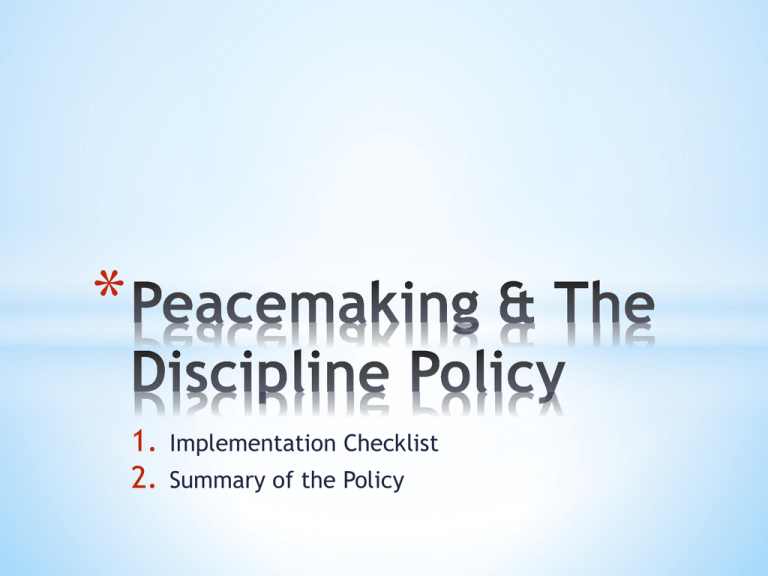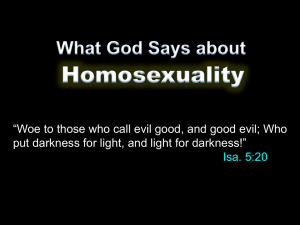Peacemaking & The Discipline Policy
advertisement

* 1. 2. Implementation Checklist Summary of the Policy * 1. A person’s sin comes to your attention a) You observe it b) Someone points out someone else’s sin to you c) A person confesses sin to you 2. If the person is an official worker, notify the superintendent. 3. In the event of “a” follow Matthew 18 and Galatians 6, using the PAUSE principle from Peacemaker Ministries. 4. In the event of “b” coach the accuser to follow Matthew 18 and Galatians 6:1 using the PAUSE principle. a) Unless someone is at risk of imminent danger, the testimony of Christ is being widely damaged, or the sin disqualifies the person from leadership/service, in which cases the pastor may go with the accuser to talk to the accused or go without the accuser. 5. In the event of “c” lead them into steps of confession, repentance, restitution with support and accountability. Proclaim the gospel to them. a) Unless someone is in imminent danger, the testimony of Christ is being widely damaged as a result of their sin, or the sin disqualifies the person from leadership/service, in those cases the pastor would proceed to implement the formal disciplinary process according to the C&MA Manual. 6. If the person in sin denies that they have sinned after you have used the PAUSE principle with them, follow step two in Matthew 18, and take someone with you to gently restore them. 7. If they continue in unrepentant sin, then implement the formal, documented level of the Discipline Policy. 8. Include the district superintendent in the conversation early in the process. 9. Do not remove a person from membership for reasons of sin, including the sin of being divisive, without following the Discipline Policy. 10.The pastor and elder board may suspend the privileges of membership. 11.Do not, as pastor, tell someone they should consider going to another church. Follow the Discipline Policy. Removing someone from membership is a decision of the elders, not the pastor. 12.Be strict in regard to the documentation requirements of the Discipline Policy. Make sure all the letters that are to be written and sent are written and sent. * * 1. The policy values a relational, personal, small circle resolution of conflict and addressing sin. a) This is different than an organizational larger circle method. 2. Three things require an organizational approach a) Someone is at risk of imminent harm or has been harmed. b) The testimony of Christ is threatened. c) The sin disqualifies the accused from leadership/service. 3. Otherwise, private resolution of a matter without a formal hearing is right when there is confession of sin and repentance by the guilty. a) As evidenced by a good confession. b) As evidenced by a repentance strategy including sufficient support and accountability. 4. In the local church non-members are not subject to discipline unless a Relational Commitment has been put in place. a) In the bylaws. b) In practice by the pastor and elders. 5. Transition from the informal, relational kind of discipline to the formal, documented kind happens when there is no confession of sin and repentance, or when someone is at risk of imminent harm, the testimony of Christ in the church and community is threatened, or the sin renders the person unqualified to serve in their position of ministry. 6. Documentation requirements are reasonable: a) The accusation may be brought verbally and then documented by the pastor or superintendent. b) Anonymous accusations are not to be entertained. 7. When the written accusation is delivered to the accused, it is best done in person with the letter given to them following a verbal presentation of the accusation. It is recommended that the PAUSE principle from Peacemaker Ministries be used in presenting the accusation. 8. All discipline in the local church is to be done in consultation with the superintendent of the district. 9. Confidentiality is not absolute but conditional. 10.It is best to talk with, by phone or in person, the accused before each of the following steps: a) e) sending the letter with the names of those performing the investigation, the written report of the investigative committee, the decision to dismiss the charges or to proceed with a hearing, the names of those you have appointed to serve on the Discipline Committee, the judgment and the restoration plan. a) b) c) d) Reprimand Probation Revocation Expulsion. b) c) d) 11.Note there are several levels of Restoration: *








